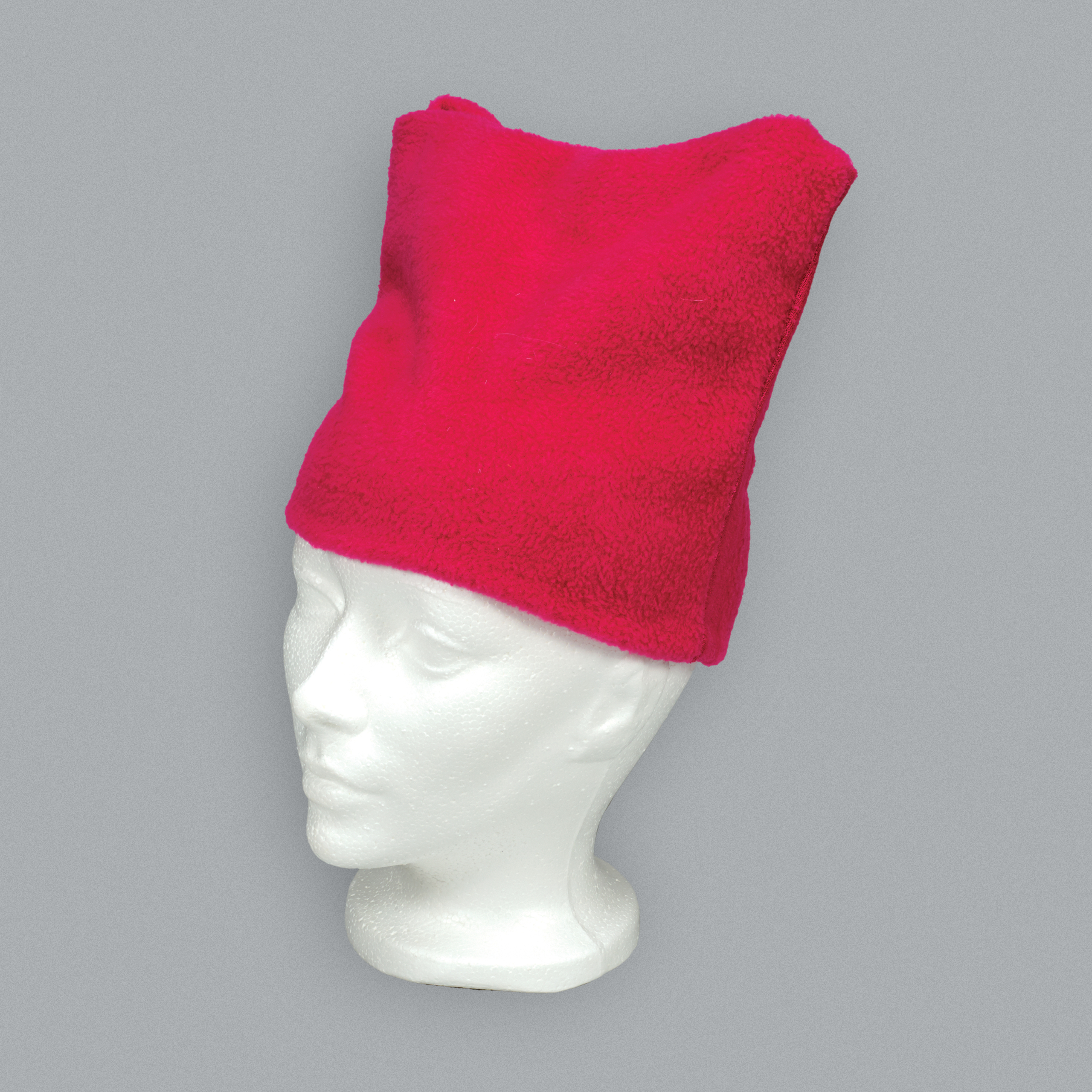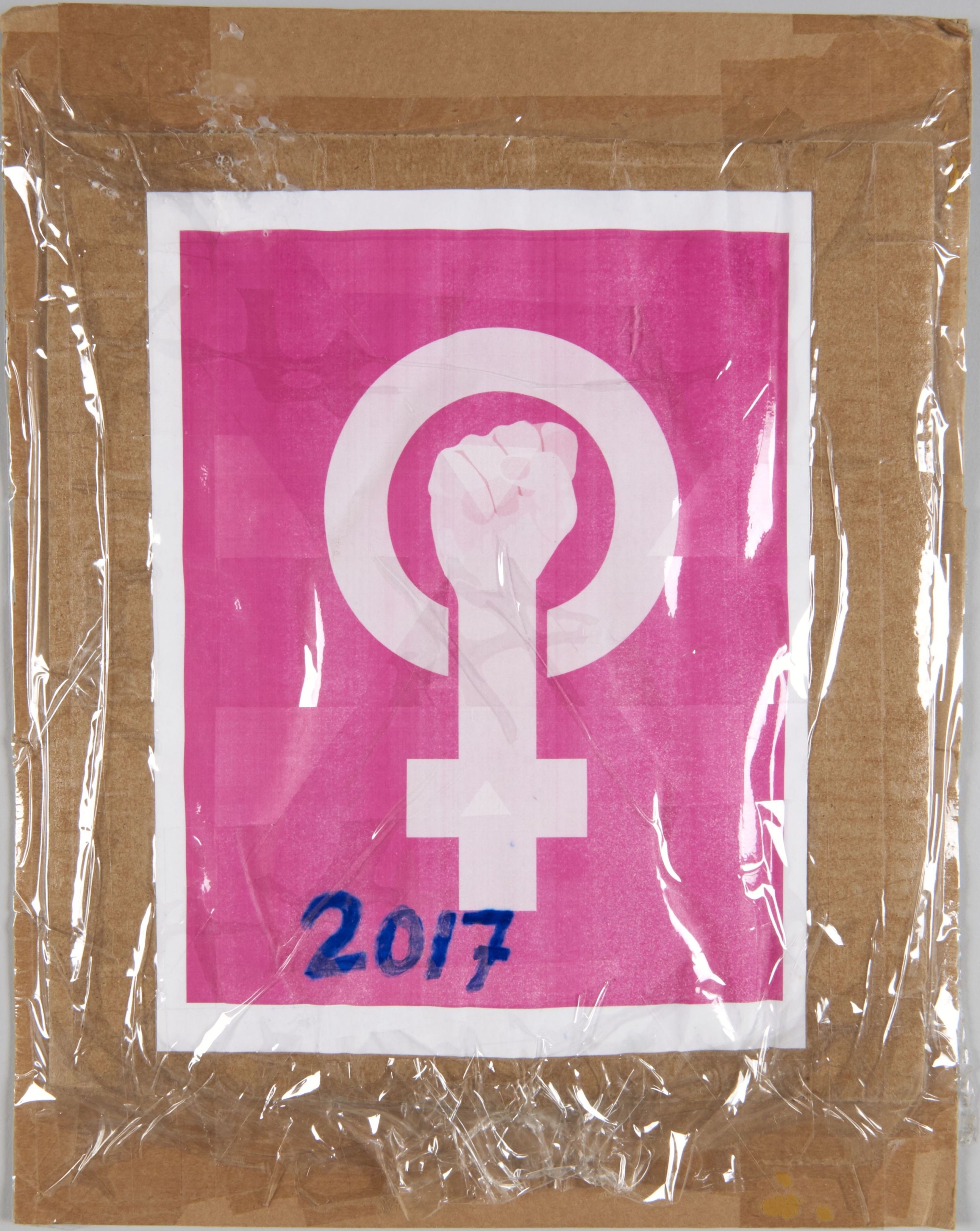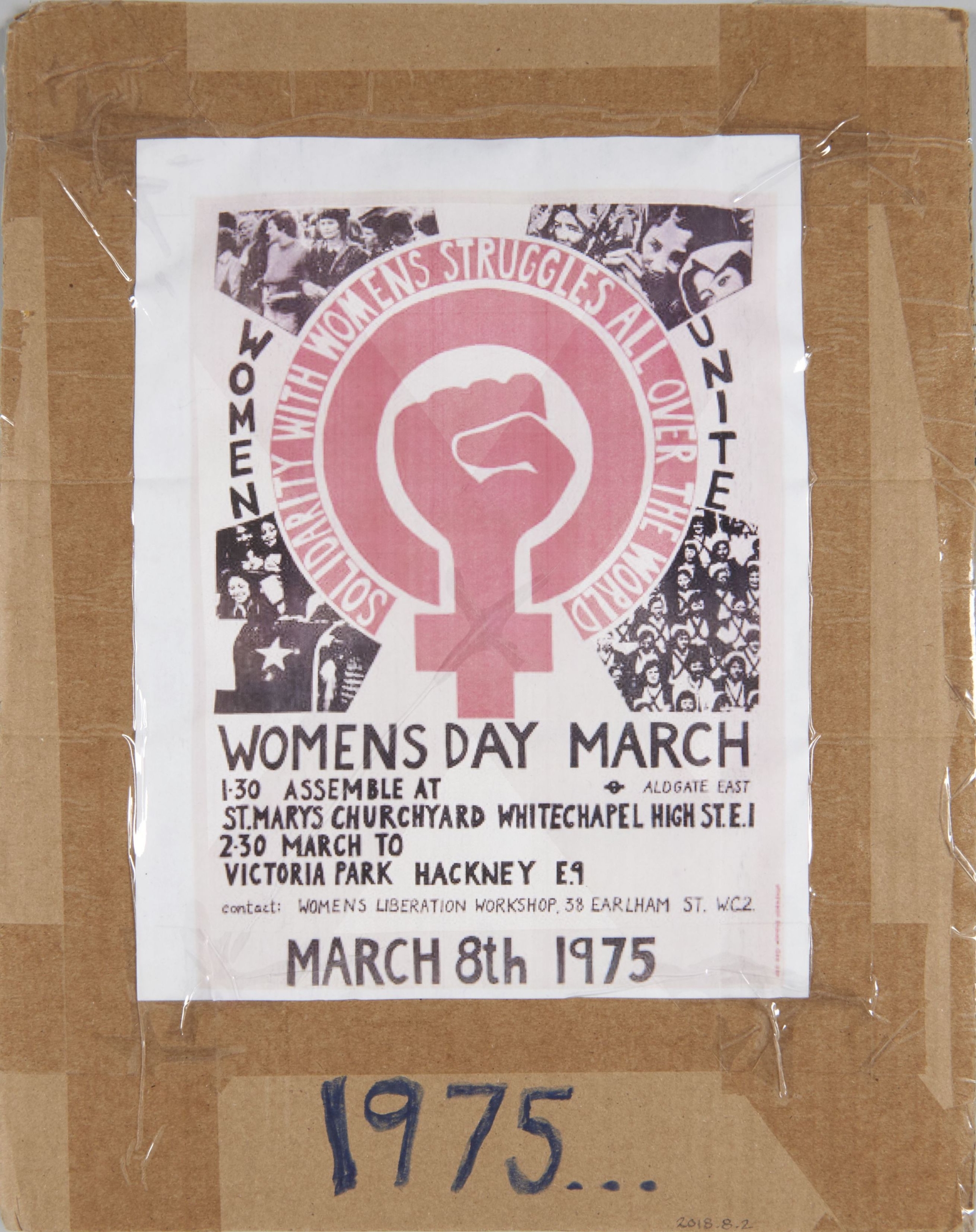Pink Hat
Artifact
Image
Video
Audio
 Activities
Activities
LOOK
Look closely at this hat. What do you think the shape and colour represent? Verify your answer by reading the Historical Context below.
DO
Take the historical perspective of a participant in the 2017 Women’s March. Create a poster for the march. What images, colours and symbols do you include? Explain your choices to a partner.
Details
 Materials
Materials - Textile
Historical Context
Choose one of the three levels below to match your needs.
- This pink “pussyhat” was worn during the Women’s March held in Ottawa on January 21, 2017.
- Such hats were made as a direct response to then-President Trump’s boasts about his right to assault women.
- The Women’s March on Washington, D.C. was timed to coincide with the beginning of President Trump’s administration. In an act of global solidarity, rallies and marches in support of women’s rights were held around the world on the same date.
Scroll through the media carousel above to see a photograph from the 2017 Women’s March in Ottawa, a poster from the March and some information from the artist, Katie Armstrong-Lestrange.
This pink “pussyhat” was worn during the Women’s March held in Ottawa on January 21, 2017. Such hats were made as a direct response to then-President Trump’s boasts about his right to assault women.
The Women’s March on Washington, D.C. was timed to coincide with the beginning of President Trump’s administration. In an act of global solidarity, rallies and marches in support of women’s rights were held around the world on the same date. Thirty-four communities across Canada participated.
Historically, Canadian and U.S. feminists have crossed borders to learn and collaborate. This practice dates from at least the 1870s, when Letitia Youmans from Upper Canada was inspired to start a Canadian chapter of the Women’s Christian Temperance Union after attending a conference in New York. The 2017 Women’s Marches are evidence of the ongoing connection between women in Canada and the United States.
This pink “pussyhat” was worn during the Women’s March held on January 21, 2017, protesting sexist remarks made by the new American president, Donald Trump, during his campaign.
“Pussyhat” is a play on words, bringing together two popular meanings of the word “pussy”: a cat (as seen in the hat’s kitty ears) or a slang term for female genitalia. Such hats were made in direct response to then-President Trump’s boasts about his right to sexually assault women.
The Women’s March on Washington, D.C. was timed to coincide with the beginning of President Trump’s administration. In an act of global solidarity, rallies and marches in support of women’s rights were held around the world on the same date. Thirty-four communities across Canada marched, attracting an estimated 110,000 participants.
Although the marches began as a protest against President Trump, the marches in Canada focused on national issues related to sexism, gender equality, missing and murdered Indigenous women and girls, and reproductive rights.
Historically, Canadian and U.S. feminists have crossed borders to learn and collaborate. This practice dates from at least the 1870s, when Letitia Youmans of Upper Canada was inspired to start a Canadian chapter of the Women’s Christian Temperance Union, after attending a conference in New York.
The 2017 Women’s Marches reflect the ongoing connection between women in Canada and the United States. Today, connecting and organizing is much easier and faster, thanks to social media. Whereas in the past, it could take months or even years for activists across Canada to find one another, in 2017 organizers were able to coordinate 34 marches in different parts of the country in far less time.
Marches in Toronto, Montréal and Ottawa attracted about 6,000 participants. Even small centres made a difference: Sandy Cove, Nova Scotia (population 65) drew 15 marchers, and made national headlines for hosting an event.
The pink hat in this kit was made by Katie Armstrong-Lestrange, a knitter and activist who lives in Newfoundland and Labrador.
- This pink “pussyhat” was worn during the Women’s March held in Ottawa on January 21, 2017.
- Such hats were made as a direct response to then-President Trump’s boasts about his right to assault women.
- The Women’s March on Washington, D.C. was timed to coincide with the beginning of President Trump’s administration. In an act of global solidarity, rallies and marches in support of women’s rights were held around the world on the same date.
Scroll through the media carousel above to see a photograph from the 2017 Women’s March in Ottawa, a poster from the March and some information from the artist, Katie Armstrong-Lestrange.
This pink “pussyhat” was worn during the Women’s March held in Ottawa on January 21, 2017. Such hats were made as a direct response to then-President Trump’s boasts about his right to assault women.
The Women’s March on Washington, D.C. was timed to coincide with the beginning of President Trump’s administration. In an act of global solidarity, rallies and marches in support of women’s rights were held around the world on the same date. Thirty-four communities across Canada participated.
Historically, Canadian and U.S. feminists have crossed borders to learn and collaborate. This practice dates from at least the 1870s, when Letitia Youmans from Upper Canada was inspired to start a Canadian chapter of the Women’s Christian Temperance Union after attending a conference in New York. The 2017 Women’s Marches are evidence of the ongoing connection between women in Canada and the United States.
This pink “pussyhat” was worn during the Women’s March held on January 21, 2017, protesting sexist remarks made by the new American president, Donald Trump, during his campaign.
“Pussyhat” is a play on words, bringing together two popular meanings of the word “pussy”: a cat (as seen in the hat’s kitty ears) or a slang term for female genitalia. Such hats were made in direct response to then-President Trump’s boasts about his right to sexually assault women.
The Women’s March on Washington, D.C. was timed to coincide with the beginning of President Trump’s administration. In an act of global solidarity, rallies and marches in support of women’s rights were held around the world on the same date. Thirty-four communities across Canada marched, attracting an estimated 110,000 participants.
Although the marches began as a protest against President Trump, the marches in Canada focused on national issues related to sexism, gender equality, missing and murdered Indigenous women and girls, and reproductive rights.
Historically, Canadian and U.S. feminists have crossed borders to learn and collaborate. This practice dates from at least the 1870s, when Letitia Youmans of Upper Canada was inspired to start a Canadian chapter of the Women’s Christian Temperance Union, after attending a conference in New York.
The 2017 Women’s Marches reflect the ongoing connection between women in Canada and the United States. Today, connecting and organizing is much easier and faster, thanks to social media. Whereas in the past, it could take months or even years for activists across Canada to find one another, in 2017 organizers were able to coordinate 34 marches in different parts of the country in far less time.
Marches in Toronto, Montréal and Ottawa attracted about 6,000 participants. Even small centres made a difference: Sandy Cove, Nova Scotia (population 65) drew 15 marchers, and made national headlines for hosting an event.
The pink hat in this kit was made by Katie Armstrong-Lestrange, a knitter and activist who lives in Newfoundland and Labrador.
Summary
- This pink “pussyhat” was worn during the Women’s March held in Ottawa on January 21, 2017.
- Such hats were made as a direct response to then-President Trump’s boasts about his right to assault women.
- The Women’s March on Washington, D.C. was timed to coincide with the beginning of President Trump’s administration. In an act of global solidarity, rallies and marches in support of women’s rights were held around the world on the same date.
Scroll through the media carousel above to see a photograph from the 2017 Women’s March in Ottawa, a poster from the March and some information from the artist, Katie Armstrong-Lestrange.
Essential
This pink “pussyhat” was worn during the Women’s March held in Ottawa on January 21, 2017. Such hats were made as a direct response to then-President Trump’s boasts about his right to assault women.
The Women’s March on Washington, D.C. was timed to coincide with the beginning of President Trump’s administration. In an act of global solidarity, rallies and marches in support of women’s rights were held around the world on the same date. Thirty-four communities across Canada participated.
Historically, Canadian and U.S. feminists have crossed borders to learn and collaborate. This practice dates from at least the 1870s, when Letitia Youmans from Upper Canada was inspired to start a Canadian chapter of the Women’s Christian Temperance Union after attending a conference in New York. The 2017 Women’s Marches are evidence of the ongoing connection between women in Canada and the United States.
In-Depth
This pink “pussyhat” was worn during the Women’s March held on January 21, 2017, protesting sexist remarks made by the new American president, Donald Trump, during his campaign.
“Pussyhat” is a play on words, bringing together two popular meanings of the word “pussy”: a cat (as seen in the hat’s kitty ears) or a slang term for female genitalia. Such hats were made in direct response to then-President Trump’s boasts about his right to sexually assault women.
The Women’s March on Washington, D.C. was timed to coincide with the beginning of President Trump’s administration. In an act of global solidarity, rallies and marches in support of women’s rights were held around the world on the same date. Thirty-four communities across Canada marched, attracting an estimated 110,000 participants.
Although the marches began as a protest against President Trump, the marches in Canada focused on national issues related to sexism, gender equality, missing and murdered Indigenous women and girls, and reproductive rights.
Historically, Canadian and U.S. feminists have crossed borders to learn and collaborate. This practice dates from at least the 1870s, when Letitia Youmans of Upper Canada was inspired to start a Canadian chapter of the Women’s Christian Temperance Union, after attending a conference in New York.
The 2017 Women’s Marches reflect the ongoing connection between women in Canada and the United States. Today, connecting and organizing is much easier and faster, thanks to social media. Whereas in the past, it could take months or even years for activists across Canada to find one another, in 2017 organizers were able to coordinate 34 marches in different parts of the country in far less time.
Marches in Toronto, Montréal and Ottawa attracted about 6,000 participants. Even small centres made a difference: Sandy Cove, Nova Scotia (population 65) drew 15 marchers, and made national headlines for hosting an event.
The pink hat in this kit was made by Katie Armstrong-Lestrange, a knitter and activist who lives in Newfoundland and Labrador.




